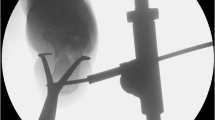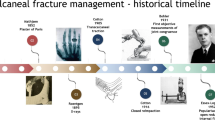Abstract
Background
Calcaneal fractures are serious injuries that mainly affect young, active people. As a result, these fractures may cause long-term impairment and have a major socioeconomic impact. The current updated systematic review and meta-analysis were conducted to evaluate the functional outcomes, re-operative risk, and complications associated with the treatment of displaced intra-articular calcaneal.
Methodology
The Preferred Reporting Items for Systematic Reviews and Meta-Analyses (PRISMA) guidelines were followed to conduct this meta-analysis. The literature search was carried out using PubMed, Cochrane, MEDLINE, Google Scholar, and the EMBASE databases with the appropriate keywords.
Results
A total of 13 studies were included in this review. The follow-up months were diverse, ranging between 12 and 65 months in sinus tarsi approach (STA) and 12 to 76 months in extended lateral approach (ELA) methods. Time to surgery was shorter for the STA when compared to ELA (MD: 3.48; 95% CI 2.43 to 4.53; p < 0.00001). No significant difference was observed in functional outcomes between STA and ELA (MD: 0.34; 95% CI: −0.37 to 1.04; p = 0.35 > 0.05; I2 = 88%). In comparison to the ELA, the STA has significantly less wound healing complications (RR: 0.20; 95% CI 0.11 to 0.36; p 0.00001; I2 = 0%).
Conclusion
In conclusion, the STA technique in treating calcaneal fractures was significantly safer and more effective when compared to the ELA methods. The STA method of treatment was found to have a lower risk of complications and an infection rate, as well as a shorter operating and recovery time.















Similar content being viewed by others
References
Gougoulias, N., McBride, D., & Maffulli, N. (2021). Outcomes of management of displaced intra-articular calcaneal fractures. The Surgeon, 19(5), e222–e229. https://doi.org/10.1016/j.surge.2020.10.003
Gupta, D. K., Garg, A., & Jindal, M. (2020). Role of percutaneous fixation of displaced intra articular calcaneal fractures with cancellous cannulated screws. IAR Journal of Medical Sciences, 1(1), 36–39.
Mitchell, M. J., McKinley, J. C., & Robinson, C. M. (2009). The epidemiology of calcaneal fractures. The Foot, 19(4), 197–200. https://doi.org/10.1016/j.foot.2009.05.001
Lim, E. V. A., & Leung, J. P. F. (2001). Complications of intraarticular calcaneal fractures. Clinical Orthopaedics and Related Research®, 391, 7–16.
Malik, C., Najefi, A. A., Patel, A., et al. (2022). Percutaneous subtalar joint screw fixation of comminuted calcaneal fractures: A salvage procedure. European Journal of Trauma and Emergency Surgery. https://doi.org/10.1007/s00068-022-01923-0
Bušková, K., Bartoníček, J., & Rammelt, S. (2021). Fractures of the base of the fifth metatarsal bone. JBJS Reviews. https://doi.org/10.2106/JBJS.RVW.21.00010
Nosewicz, T. L., Dingemans, S. A., Backes, M., Luitse, J. S. K., Goslings, J. C., & Schepers, T. (2019). A systematic review and meta-analysis of the sinus tarsi and extended lateral approach in the operative treatment of displaced intra-articular calcaneal fractures. Foot and Ankle Surgery, 25(5), 580–588. https://doi.org/10.1016/j.fas.2018.08.006
Ozturk, A. M., Ozer, M. A., Suer, O., Derin, O., Govsa, F., & Aktuglu, K. (2022). Evaluation of the effects of using 3D - patient specific models of displaced intra - articular calcaneal fractures in surgery. Injury. https://doi.org/10.1016/j.injury.2020.04.057
Nosewicz, T., Knupp, M., Barg, A., et al. (2012). Mini-open sinus tarsi approach with percutaneous screw fixation of displaced calcaneal fractures: A prospective computed tomography–based study. Foot & Ankle International, 33(11), 925–933. https://doi.org/10.3113/FAI.2012.0925
Zhang, W., Lin, F., Chen, E., Xue, D., & Pan, Z. (2016). Operative versus nonoperative treatment of displaced intra-articular calcaneal fractures. Journal of Orthopaedic Trauma, 30(3), e75–e81. https://doi.org/10.1097/BOT.0000000000000446
Ågren, P. H., Wretenberg, P., & Sayed-Noor, A. S. (2013). Operative versus nonoperative treatment of displaced intra-articular calcaneal fractures. The Journal of Bone & Joint Surgery, 95(15), 1351–1357. https://doi.org/10.2106/JBJS.L.00759
Pastor, T., Gradl, G., Klos, K., et al. (2016). Displaced intra-articular calcaneal fractures: Is there a consensus on treatment in Germany? International Orthopaedics, 40(10), 2181–2190. https://doi.org/10.1007/s00264-016-3134-2
Zhang Y, Weng Q, Chen J, Yang Y (2021) The spatial weaving screw technique combined with minimally invasive treatment of calcaneal fracture. https://www.researchsquare.com/article/rs-244666/latest.pdf.
Benirschke, S. K., & Kramer, P. A. (2004). Wound healing complications in closed and open calcaneal fractures. Journal of Orthopaedic Trauma, 18(1), 1–6.
Meena, S., Gangary, S. K., & Sharma, P. (2016). Review article: Operative versus non-operative treatment for displaced intra-articular calcaneal fracture: A meta-analysis of randomised controlled trials. Journal of Orthopaedic Surgery, 24(3), 411–416. https://doi.org/10.1177/1602400328
Liberati, A., Altman, D., Tetzlaff, J., et al. (2009). The PRISMA statement for reporting systematic reviews and meta-analyses of studies that evaluate health care interventions: Explanation and elaboration. PLoS Medicine, 6(7), 100. https://doi.org/10.1371/journal.pmed.1000100
Higgins, J. P. T., Altman, D. G., Gotzsche, P. C., et al. (2011). The Cochrane collaboration’s tool for assessing risk of bias in randomised trials. BMJ, 343, d5928. https://doi.org/10.1136/bmj.d5928
Slim, K., Nini, E., Forestier, D., Kwiatkowski, F., Panis, Y., & Chipponi, J. (2003). Methodological index for non-randomized studies (MINORS): Development and validation of a new instrument. ANZ Journal of Surgery, 73(9), 712–716. https://doi.org/10.1046/j.1445-2197.2003.02748.x
Li, L.-h, Guo, Y.-z, Wang, H., et al. (2016). Less wound complications of a sinus tarsi approach compared to an extended lateral approach for the treatment of displaced intraarticular calcaneal fracture. Medicine (Baltimore), 95(36), e4628. https://doi.org/10.1097/MD.0000000000004628
Yeo, J. H., Cho, H. J., & Lee, K. B. (2015). Comparison of two surgical approaches for displaced intra-articular calcaneal fractures: Sinus tarsi versus extensile lateral approach. BMC Musculoskeletal Disorders, 16(1), 63. https://doi.org/10.1186/s12891-015-0519-0
Wang, J., Qin, S., Wang, T., Liu, J., & Wang, Z. (2021). Comparison of the curative effect of percutaneous reduction with plastic calcaneal forceps combined with medial external fixation in the treatment of intra-articular calcaneal fractures. Orthopaedic Surgery, 13(8), 2344–2354. https://doi.org/10.1111/os.13118
Schepers, T., Backes, M., Dingemans, S. A., de Jong, V. M., & Luitse, J. S. K. (2017). Similar anatomical reduction and lower complication rates with the sinus tarsi approach compared with the extended lateral approach in displaced intra-articular calcaneal fractures. Journal of Orthopaedic Trauma, 31(6), 293–298. https://doi.org/10.1097/BOT.0000000000000819
Kline, A. J., Anderson, R. B., Davis, W. H., Jones, C. P., & Cohen, B. E. (2013). Minimally invasive technique versus an extensile lateral approach for intra-articular calcaneal fractures. Foot & Ankle International, 34(6), 773–780. https://doi.org/10.1177/1071100713477607
Zhou, H.-c, Yu, T., Ren, H.-y, et al. (2017). Clinical comparison of extensile lateral approach and sinus tarsi approach combined with medial distraction technique for intra-articular calcaneal fractures. Orthopaedic Surgery, 9(1), 77–85. https://doi.org/10.1111/os.12310
Basile, A., Albo, F., & Via, A. G. (2016). Comparison between sinus tarsi approach and extensile lateral approach for treatment of closed displaced intra-articular calcaneal fractures: A multicenter prospective study. Journal of Foot and Ankle Surgery, 55(3), 513–521. https://doi.org/10.1053/j.jfas.2015.11.008
Weber, M., Lehmann, O., Sägesser, D., & Krause, F. (2008). Limited open reduction and internal fixation of displaced intra-articular fractures of the calcaneum. The Journal of Bone & Joint Surgery British, 90-B(12), 1608–1616. https://doi.org/10.1302/0301-620X.90B12.20638
Xia, S., Lu, Y., Wang, H., Wu, Z., & Wang, Z. (2014). Open reduction and internal fixation with conventional plate via L-shaped lateral approach versus internal fixation with percutaneous plate via a sinus tarsi approach for calcaneal fractures – a randomized controlled trial. International Journal of Surgery, 12(5), 475–480. https://doi.org/10.1016/j.ijsu.2014.03.001
Howard, J. L., Buckley, R., McCormack, R., et al. (2003). Complications following management of displaced intra-articular calcaneal fractures: A prospective randomized trial comparing open reduction internal fixation with nonoperative management. Journal of Orthopaedic Trauma, 17(4), 241–249. https://doi.org/10.1097/00005131-200304000-00001
Jiang, N., Lin, Q.-r, Diao, X.-c, Wu, L., & Yu, B. (2012). Surgical versus nonsurgical treatment of displaced intra-articular calcaneal fracture: a meta-analysis of current evidence base. International Orthopaedics, 36(8), 1615–1622. https://doi.org/10.1007/s00264-012-1563-0
Thakore, R. V., Greenberg, S. E., Shi, H., et al. (2015). Surgical site infection in orthopedic trauma: A case–control study evaluating risk factors and cost. Journal of Clinical Orthopaedics and Trauma, 6(4), 220–226. https://doi.org/10.1016/j.jcot.2015.04.004
Clement, R. C., Lang, P. J., Pettett, B. J., Overman, R. A., Ostrum, R. F., & Tennant, J. N. (2017). Sanders II/III calcaneus fractures in laborers: A cost-effectiveness analysis and call for effectiveness research. Journal of Orthopaedic Trauma, 31(6), 299–304. https://doi.org/10.1097/BOT.0000000000000813
Borrelli, J., & Lashgari, C. (1999). Vascularity of the lateral calcaneal flap: A cadaveric injection study. Journal of Orthopaedic Trauma, 13(2), 73–77. https://doi.org/10.1097/00005131-199902000-00001
Takasaka, M., Bittar, C. K., Mennucci, F. S., de Mattos, C. A., & Zabeu, J. L. A. (2016). Comparative study on three surgical techniques for intra-articular calcaneal fractures: Open reduction with internal fixation using a plate, external fixation and minimally invasive surgery. Revista Brasileira de Ortopedia, 51(3), 254–260. https://doi.org/10.1016/j.rboe.2016.04.002
Chen, J., Yang, Z., Kong, C., & Wei, S. (2020). Minimally invasive dual incision with mini plate internal fixation improves outcomes over 30 months in 20 patients with Sanders type III calcaneal fractures. Journal of Orthopaedic Surgery and Research, 15(1), 167. https://doi.org/10.1186/s13018-020-01644-3
Gao, X., Fan, H., Huang, R., Sui, Y., Li, F., & Yin, H. (2021). Management of open calcaneal fractures with medial wounds by one-stage sequential reduction and frame structure fixation using percutaneous Kirschner wires. Orthopaedic Surgery, 13(1), 225–236. https://doi.org/10.1111/os.12902
Cursaru, A., Crețu, B., Șerban, B., et al. (2022). Minimally invasive treatment and internal fixation vs. extended lateral approach in calcaneus fractures of thalamic interest. Experimental and Therapeutic Medicine, 23(3), 196. https://doi.org/10.3892/etm.2022.11119
Funding
No external source of funding was received for the subject matter of this manuscript.
Author information
Authors and Affiliations
Corresponding author
Ethics declarations
Conflict of interest
The authors declare that they have no conflict of interest.
Ethical standard statement
This article does not contain any studies with human or animal subjects performed by the any of the authors.
Informed consent
For this type of study informed consent is not required.
Additional information
Publisher's Note
Springer Nature remains neutral with regard to jurisdictional claims in published maps and institutional affiliations.
Rights and permissions
Springer Nature or its licensor (e.g. a society or other partner) holds exclusive rights to this article under a publishing agreement with the author(s) or other rightsholder(s); author self-archiving of the accepted manuscript version of this article is solely governed by the terms of such publishing agreement and applicable law.
About this article
Cite this article
Bandyopadhyay, A., Kumar, S. & Mandal, P. Calcaneal Fractures Management, Change of Clinical Practice in Recent Years from ELA to STA: A Systematic Review and Meta-Analysis. JOIO 57, 800–817 (2023). https://doi.org/10.1007/s43465-023-00871-0
Received:
Accepted:
Published:
Issue Date:
DOI: https://doi.org/10.1007/s43465-023-00871-0




